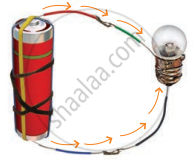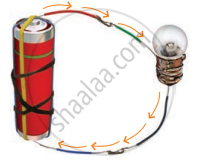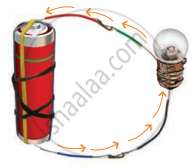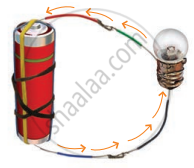Advertisements
Online Mock Tests
Chapters
2: Components of Food
3: Fibre to Fabric
4: Sorting Materials and Groups
5: Separation of Substances
6: Changes Around Us
7: Getting to Know Plants
8: Body Movement
9: The Living Organisms and their Surroundings
10: Motion and Measurement of Distances
11: Light
▶ 12: Electricity and Circuits
13: Fun with Magnets
14: Water
15: Air Around Us
16: Garbage in, Garbage out
![NCERT Exemplar solutions for Science [English] Class 6 chapter 12 - Electricity and Circuits NCERT Exemplar solutions for Science [English] Class 6 chapter 12 - Electricity and Circuits - Shaalaa.com](/images/science-english-class-6_6:5f2b1b2038084cf381bfa42c826a928c.jpg)
Advertisements
Solutions for Chapter 12: Electricity and Circuits
Below listed, you can find solutions for Chapter 12 of CBSE NCERT Exemplar for Science [English] Class 6.
NCERT Exemplar solutions for Science [English] Class 6 12 Electricity and Circuits Multiple Choice Questions [Pages 72 - 74]
Choose from the options a, b, c and d given in Fig. 12.1 the figure which shows the correct direction of current.
Choose the incorrect statement.
A switch is the source of electric current in a circuit.
A switch help to complete or break the circuit.
A switch helps us to use electricity as per our requirement.
When the switch is open there is an air gap between its terminals.
In an electric bulb, light is produced due to the glowing of
the glass case of the bulb.
the thin filament.
the thick wires supporting the filament.
gases inside glass case of the bulb.
In the following arrangement shown in Fig. 12.2, the bulb will not glow if the ends A and B are connected with
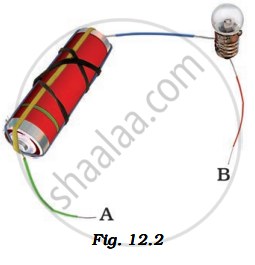
A steel spoon
A metal clip
A plastic clip
A copper wire
In the circuit shown in Fig. 12.3, when the switch is moved to ‘ON’ position,

the bulb A will glow first.
the bulb B will glow first.
the bulb C will glow first.
all bulbs will glow together
Filament of a torch bulb is
a metal case.
metal tip at the centre of the base.
two thick wires
a thin wire
Paheli is running short of connecting wires. To complete an electric circuit, she may use a
glass bangle.
thick thread.
rubber pipe.
steel spoon.
NCERT Exemplar solutions for Science [English] Class 6 12 Electricity and Circuits Very Short Answer Questions [Pages 74 - 75]
In which of the following circuits A, B, and C gave in Fig. 12.4, the cell will be used up very rapidly?
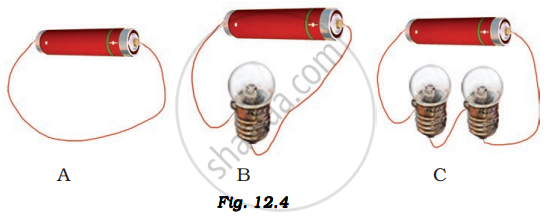
Fig. 12.5 shows a bulb with its different parts marked as 1, 2, 3, 4, and 5. Which of them labels the terminals of the bulb?

NCERT Exemplar solutions for Science [English] Class 6 12 Electricity and Circuits Short Answer Questions [Pages 75 - 77]
You are provided with a bulb, a cell, a switch and some connecting wires. Draw a diagram to show the connections between them to make the bulb glow.
Will the bulb glow in the circuit shown in Fig. 12.6? Explain.
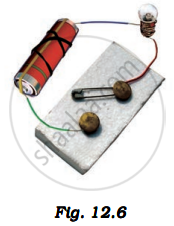
An electric bulb is connected to a cell through a switch as shown in Fig. 12.7. When the switch is brought in the ‘ON’ position, the bulb does not glow. What could be the possible reason/s for it? Mention any two of them.
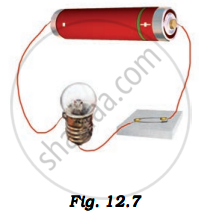
A torch requires 3 cells. Show the arrangement of the cells, with a diagram, inside the torch so that the bulb glows.
When the chemicals in the electric cell are used up, the electric cell stops producing electricity. The electric cell is then replaced with a new one. In case of rechargeable batteries (such as the type used in mobile phones, camera and inverters), they are used again and again. How?
Paheli connected two bulbs to a cell as shown in Fig. 12.8.

She found that filament of bulb B is broken. Will the bulb A glow in this circuit? Give reason.
Why do bulbs have two terminals?
Which of the following arrangement A, B, C, and D gave in Fig. 12.9 should not be set up? Explain, why.
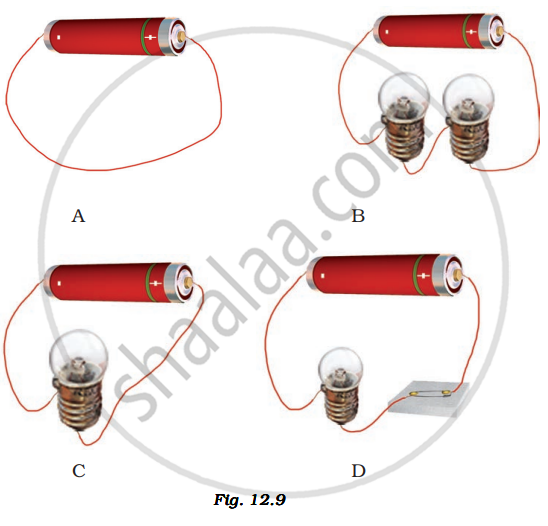
A fused bulb does not glow. Why?
Paheli wanted to glow a torch bulb using a cell. She could not get connecting wires, instead, she got two strips of aluminium foil. Will she succeed? Explain, how?
NCERT Exemplar solutions for Science [English] Class 6 12 Electricity and Circuits Long Answer Questions [Pages 77 - 78]
Boojho has a cell and a single piece of connecting wire. Without cutting the wire in two, will he be able to make the bulb glow? Explain with the help of a circuit diagram.
Fig. 12.10 A and B, show a bulb connected to a cell in two different ways.
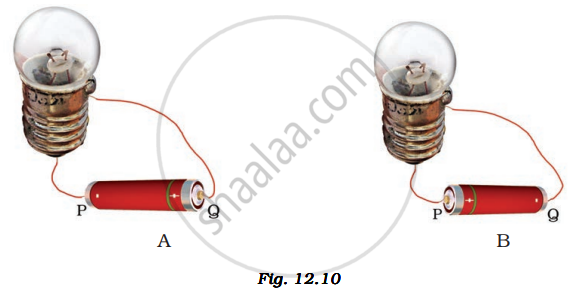
What will be the direction of the current through the bulb in both the cases. (Q to P or P to Q)
Fig. 12.10 A and B, show a bulb connected to a cell in two different ways.
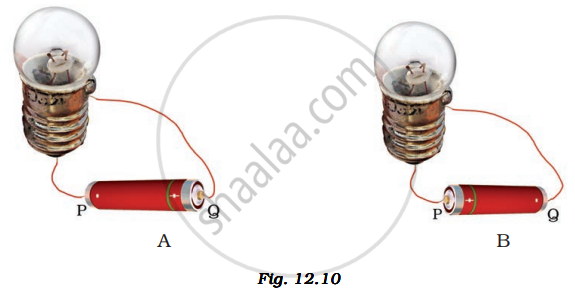
Will the bulb glow in both the cases?
Fig. 12.10 A and B, show a bulb connected to a cell in two different ways.
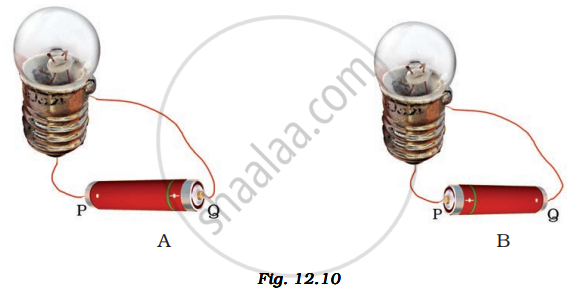
Does the brightness of the glowing bulb depend on the direction of current through it?
Think of six activities that use electric current. Also, name the devices used to perform the activity.
| Example: | Activity you perform | Device |
| Get light | Torch | |
A torch is not functioning, though contact points in the torch are in working condition. What can be the possible reasons for this? Mention any three.
Solutions for 12: Electricity and Circuits
![NCERT Exemplar solutions for Science [English] Class 6 chapter 12 - Electricity and Circuits NCERT Exemplar solutions for Science [English] Class 6 chapter 12 - Electricity and Circuits - Shaalaa.com](/images/science-english-class-6_6:5f2b1b2038084cf381bfa42c826a928c.jpg)
NCERT Exemplar solutions for Science [English] Class 6 chapter 12 - Electricity and Circuits
Shaalaa.com has the CBSE Mathematics Science [English] Class 6 CBSE solutions in a manner that help students grasp basic concepts better and faster. The detailed, step-by-step solutions will help you understand the concepts better and clarify any confusion. NCERT Exemplar solutions for Mathematics Science [English] Class 6 CBSE 12 (Electricity and Circuits) include all questions with answers and detailed explanations. This will clear students' doubts about questions and improve their application skills while preparing for board exams.
Further, we at Shaalaa.com provide such solutions so students can prepare for written exams. NCERT Exemplar textbook solutions can be a core help for self-study and provide excellent self-help guidance for students.
Concepts covered in Science [English] Class 6 chapter 12 Electricity and Circuits are Electricity, Electric cell, A Bulb Connected to an Electric Cell, Electric Circuit, Electric Switch, Conductors and Insulators.
Using NCERT Exemplar Science [English] Class 6 solutions Electricity and Circuits exercise by students is an easy way to prepare for the exams, as they involve solutions arranged chapter-wise and also page-wise. The questions involved in NCERT Exemplar Solutions are essential questions that can be asked in the final exam. Maximum CBSE Science [English] Class 6 students prefer NCERT Exemplar Textbook Solutions to score more in exams.
Get the free view of Chapter 12, Electricity and Circuits Science [English] Class 6 additional questions for Mathematics Science [English] Class 6 CBSE, and you can use Shaalaa.com to keep it handy for your exam preparation.
